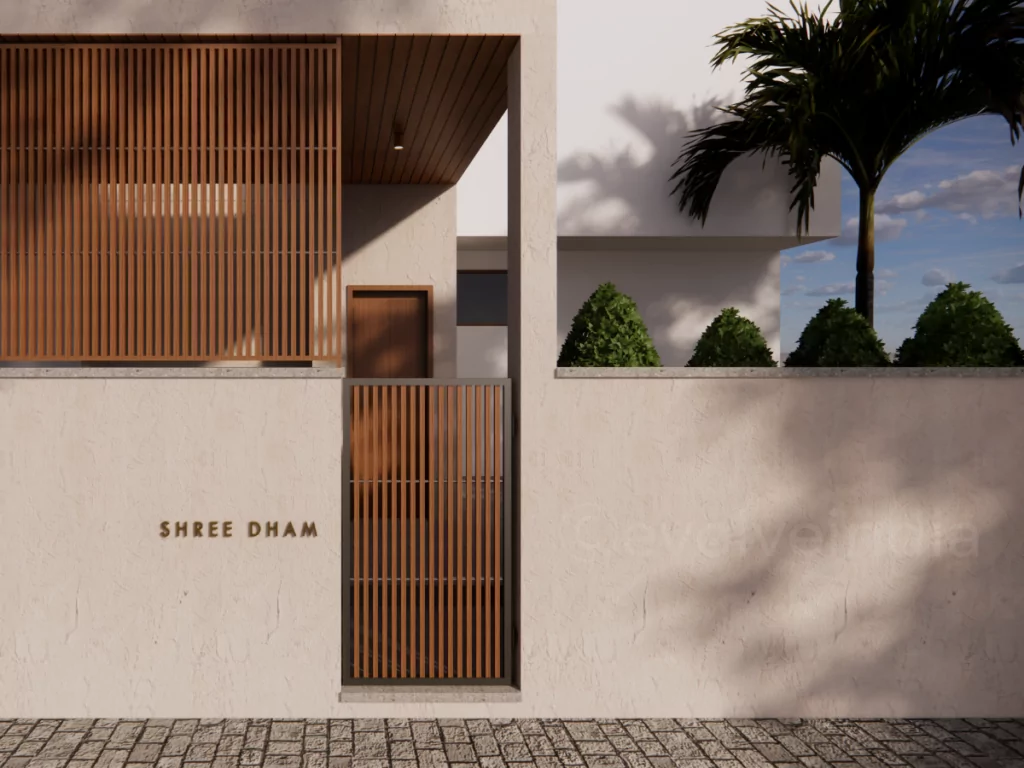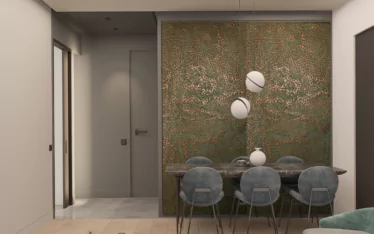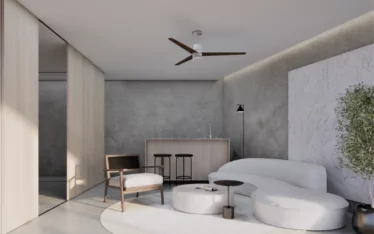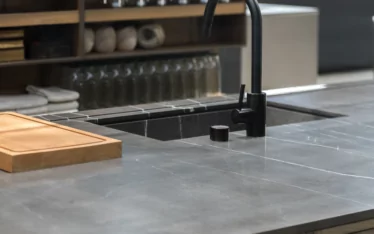Disclaimer – We at Evolve are manufacturers of premium interior products that are crafted using new-age building materials like liquid metal and decorative concrete. Please visit our products page to learn more about our offerings and services. We are also on the lookout for channel partners to help increase our presence. Visit our partner page to learn more about the partnership opportunities.
Luxury and innovation are converging in the ever-evolving world of architecture. This is most apparent in modern house exterior designs, since the street-facing facade is what steals attention of the onlookers. Aspirational homeowners across the globe are seeking to expand their design vocabulary – to seamlessly blend opulence and sustainability, and timeless elegance with contemporary charm. Modern luxurious house exterior designs pepper the landscape of our world, from sleek urban homes and serene countryside getaways to breezy, beach-side homes. Evolve India brings to you a thorough study of the top 5 materials set to define the essence of modern luxury house exteriors in the coming years.
1. Decorative Concrete: Featuring Extensive Flexibility
One of the most common materials used in construction, concrete, takes the top spot in our list of materials for modern home exterior design. And a modern day innovation of concrete, perfect for crafting surfaces with an unmatched aesthetic is decorative concrete. With decorative concrete, a material known for its strength, durability, and versatility, you can craft a range of house exterior designs. From a dramatic and dynamic curved facade using structural concrete to a simple and minimalist textured look with a decorative finish, concrete gives you the space and freedom to experiment.
Photos by Iwan Baan; via Steven Holl Architects
Source: Architizer
With Evolve’s decorative concrete coatings, you can craft multiple colours and textures that are highly durable, breathable and elastomeric, while offering a spectrum of visual novelty. Concrete’s rugged and exposed aesthetic also brings a brutalist charm to your modern luxurious house exterior design.

Pros:
- Concrete exterior designs are incredibly versatile, offering unparallel flexibility.
- Exposed construction concrete can bring down project costs by significant margins.
- The aesthetic result of concrete exterior designs are incredible, suffusing your home with rugged character.
- Concrete is extremely durable and hence greatly reduces eventual maintenance charges.
- Concrete provides good thermal insulation and is fire resistant.
- Decorative concrete finishes provide endless possibilities of colours and textures.
- Inherently an easy material to work with, decorative concrete application is also a comparatively quick and seamless process.
- Concrete can also be made of recycled materials, making it an eco-friendly option.
Photos by Hufton and Crow; via Heatherwick Studio.
Source: Architizer
Limitations:
- After degradation, concrete can potentially show cracks due to seepage and expansion.
- If subjected to freeze-thaw cycles, the composition of concrete may disrupt leading to crumbling and cracking.
- Untreated concrete is subject to pollution, and can discolour over time.
- Rusting of steel reinforcements inside concrete can cause the surface to burst around these points, and discoulored streaks as well.
- Over time, concrete can also be subject to biological growth.
Suited for:
A well-rounded material, concrete – poured on site, pre-cast or used as a decorative finish – can be used across climatic conditions and geographies. Its insulation properties make it a good fit for extreme temperatures – provided it is treated properly to ensure limited exposure to moisture.
2. Corten Steel: A World Of Earthy-toned Charm
Taking the world of design by storm, corten steel is making waves as one of the most well-known metal facade materials. A corten steel house exterior will only add to the luxe quotient of your modern luxurious house design. Characterized by their arresting patina of rust that gives of a lovely reddish-brown hue, corten steel facades combine the age-old rustic look of weathering with a starkly contemporary aesthetic. Installed in the form of metal panels, corten steel also affords a high level of flexibility and innovation. Despite weathering to change colour over time, corten steel is treated so as to not let this process affect its structural integrity.
Photos by Rasmus Hjortshøj; via BIG.
Source: Dezeen
Taking the ease of applying corten steel panels a step further, paintable metal and rust finishes – such as Evolve’s Rust finishes – are now available on the market. These allow you to control the patination of corten steel to achieve a desired shade while being eco-friendly. The innovation is seamlessly ease to apply, and also comes in simple DIY kits.

Pros:
- Corten steel is almost like a natural and dynamic work of art, with its colours and patterns changing over time.
- Corten steel exteriors have water-resistant properties that are stronger than most other metal panels and can survive up to ten times longer than traditional steel.
- It offers a spectacular weight-to-strength ratio for a lightweight and convenient facade cladding option.
- Corten steel plates can be layered on even the most complex and parametric forms, providing flexibility.
- Corten steel plate joints fuse over time as the patina develops, ultimately leading to a seamless finish.

Limitations:
- Initial costs of sourcing and installation of corten steel panels are more expensive that other traditional materials like brick or concrete. Although with Evolve’s Paintable Rust material, one can now craft non-bleeding corten steel facades that stay intact for years.
- Corten steel requires regular maintenance, including cleaning the applicable surfaces and applying anti-corrosion protective coatings.
- Also known as weathering steel, corten steel produces rust runoff during the initial rusting phase that can stain surrounding materials.
- Corten steel’s rust layer is sensitive to abrasion, including scratches, scuff marks and more. This can affect patina development.
- It is not as fire resistant as some other materials such as concrete and masonry can be.
- While corten steel is corrosion resistance, water may get trapped between overlapping panels or tight joints, causing localized corrosion.
Suited for:
Corten steel offers a good fit when it comes to house exterior design for dry arid and temperate climates. Paradoxically, it can also be used for mild to moderate marine environments as the chloride in the air speeds up rust and corrosion, which protects the steel underneath. Environments with good air circulation are also well-suited since corten steel dries quickly,and prolonged exposure to moisture degrades it.
3. Bricks: Steps To Building Beauty
An absolute classic in the world of architectural materials, brick is synonymous with earthy charm. When used in the construction of exposed facades, they lend grace with their reddish-brown tone, geometric stacking and characteristic warmth and texture. Beyond their aesthetic allure, brick also comes with a range of practical advantages. One cannot question the enduring appeal of this timeless building material when it comes to house exterior design. Having played a pivotal role in shaping architecture across civilizations, this material will infuse a sense of history and character into a modern luxury villa.
Photos by Xiaoming Zhang
Source: Arch Daily
Pros:
- The aesthetic allure of brick as a house exterior design material is unmatched. Bricks can come together in various patterns, colours and textures for an endless canvas of options.
- Bricks can laid out in a variety of ways, allowing for the construction of screens and jaalis as well as solid walls.
- The inherent beauty of brick also goes hand in hand with low maintenance. Bricks retain lustre with minimum upkeep, while aging gracefully without compromising structural integrity.
- Among the most durable materials, brick facades resist damage from a broad spectrum – including wind, rain, pests, and fire.
- With remarkable thermal mass properties, bricks act as excellent natural insulators, regulating indoor temperatures.
- Brick walls also offer superior acoustic insulation compared to other light-weight materials.
- Embodying sustainability, bricks are produced from natural clay and use less energy during their entire life cycle than other synthetic materials. They can also be repurposed, reducing their environmental impact.
Photos by Jack Lovel
Source: Arch Daily
Limitations:
- The initial costs of building a brick facade can be pretty high as compared to other lightweight materials.
- Installation of a brick facade can be time consuming, as it requires skilled craftsmanship and labour, as well as time-intensive brick laying.
- While bricks have thermal insulation properties, it is not a match for modern materials specifically engineered for energy efficiency.
- Bricks can be heavy, and they require robust structural systems to support their weight. Proper engineering is crucial in order for the building to withstand the load of bricks.
- Bricks require proper waterproofing as they tend to absorb moisture in environments with high humidity or rainfall. This could lead to efflorescence (appearance of salts on the surface of bricks leaving behind a powder-white residue) or even mold growth.
- Eventually, with extended exposure to sunlight and weathering, bricks may fade in colour.
Suited for:
Brick’s adaptability is one of the main reasons for its enduring popularity as a building material. They perform well in arid regions since they can keep interiors cool during hot days. They can also withstand marine environments and insulate excellently against cold winters and hot summers in continental climates.
4. Timber: A Warm Tale Of Nature
A symbiosis of human creativity and nature’s exquisite beauty, timber is another timeless facade to employ for your modern villa facade. Wood has been harnessed as a trusted building materials for centuries. Timber also invokes a sense of tranquility, bringing natural warmth into the design while blending it seamlessly with the surrounding landscape. Its allure is not limited to just aesthetics, but also the sustainability principles it embodies. Timber has emerged as a renewable resource in a world embracing eco-consciousness, and is a perfect next step to embracing green construction.
Photos by Kiearch
Source: Design Boom
Pros:
- Timber showcases an inherent symphony of natural beauty,with stunning grain patterns, textures and tones.
- This material is a renewable resource, and responsible forest management also ensures that for every tree harvested, new trees are planted, preserving the balance.
- Timber establishes a strong biophilic connection while easily blurring boundaries between the indoors and outdoors.
- Timber can ensure indoor thermal comfort by reducing heat transfer through walls, thus contributing to energy efficiency.
- An extremely versatile material, timber allows for myriad creative possibilities for house exterior design. You can create intricate patterns and even imitate lace-like delicateness with this material.
- Wood inherently fosters a sense of warmth, comfort and well-being due to its close link to all things natural, thus creating a seamlessly welcoming space.
Photos by MSR Design/Ceresit
Source: Rethinking The Future
Limitations:
- The initial investment for timber facades is higher compared to other, low-cost materials.
- Timber requires extensive protection against moisture. Failure to do so can lead to rot, warping and even fungal growth.
- Untreated timber presents a fire hazard and adhering to fire-resistant treatments and building codes is absolutely crucial.
- Timber, being a natural material, undergoes weathering and may change colour over time. Regular maintenance and protective coatings can preserve its appearance.
- Timber facades attract insects and pests and if not treated for this, can be susceptible to potential infestations and especially termites.
- While durable, timber facades require regular upkeep, including sanding, sealing and addressing any damages.
Suited for:
Timber facades are best suited for climates which do not receive much rainfall and moisture. They are apt for mountainous regions, since the wood’s ability to retain heat particularly aids thermal insulation.
5. Glass: A Gift Of Technology
A testament to how far mankind has come, glass as a material represents a captivating blend of technological modernity and sleek elegance. It seamlessly blends indoors with outdoors for an ambiance of complete openness. It also bathes interior spaces with abundant natural light, while providing stunning panoramic vistas of the landscape. At the very pinnacle of contemporary design, glass will add a delightful layer of cutting-edge grace to your modern house exterior design.
Photos by Imre Csany
Source: Arch Daily
Pros:
- Transparent in nature, no other material can rival glass when it comes to creating open, airy and light-filled spaces, thus reducing the requirement for artificial lighting during the day.
- Glass affords unobstructed views of the surroundings. It can thus be used to capitalize on particularly scenic landscapes.
- Espousing sleek lines and minimalist aesthetics, glass can be used for making a contemporary statement.
- An extremely diverse and versatile material, glass allows a spectrum of design possibilities – from frameless floor-to-ceiling windows to innovative curtain walls. It also comes in varying levels of transparency.
- High-quality glass comes with a range of energy-efficient options and can contribute to great thermal performance. With add-ons like double and triple glazed options and low-emissive coatings, you can craft the most-efficient glass best suited for your location.
- Modern glass also offers excellent sound insulation properties.
Photos by Paul Smith
Source: Architecture Beast
Limitations:
- Increased solar heat gain is always a concern when it comes to large glass surfaces, and can heat interiors. Thoughtful design and shading solutions can help control it.
- Similar to heat gain, standard glass can also lead to heat loss in colder climates, prevention of which may require additional insulation measures.
- Glass facades can compromise on privacy, requiring additional features such as curtains, blinds and frosted glass to ensure the same.
- Glass facades are susceptible to impact, breakage and damages. Tempered or laminated glass is thus used for strength, but this drives up the costs.
- Glass can accumulate dirt, grime and water spots, and thus requires regular cleaning and maintenance to retain its sparkling and clear appearance.
- Top-grade glass treated for the above cons can be costly. The investment should thus be weighed against long-term benefits.
Suited for:
This is among the few materials that does not present any issues when faced with coastal air, while maximizing on the scenic beauty. Glass is also well-suited for urban environments. Glass facades can also be extensively used in temperate, Mediterranean and mountainous regions.
To Sum It Up…
Traversing across geographies, aesthetics and functionalities, each material encapsulates a distinct essence. Whether embracing a rustic, traditional charm or embracing contemporary elegance, a palette of the 5 materials mentioned above can be combined in various permutations to achieve an exterior look doused in effortless luxury.
Note: We at Evolve manufacture exquisite surfaces in the form of wall panels and door skins which can be supplied to projects globally. We are based out of Mumbai, India, and have catered to projects nationally as well as internationally including Dubai, Kuwait, Bahrain, Riyadh, Italy, Kuala Lumpur, and Malaysia. Our specialty is working with new-age building materials like liquid metal, decorative textured concrete, and paintable corten steel.
We work with architects, interior designers, fit-out contractors, furniture manufacturers, and new homeowners. And are always on the lookout to collaborate with potential stockists and retailers worldwide.
If you are looking to source unique surfaces for your interior design projects fill out the form below to receive our e-catalog.







